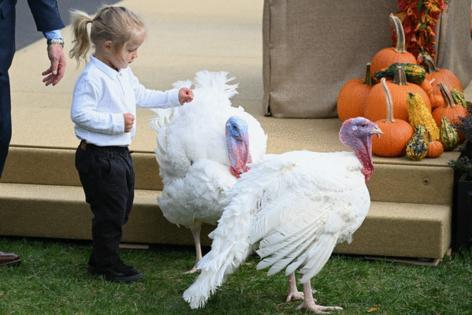Commentary: Give turkeys a reason to purr
Published in Op Eds
When I was offered an internship at a sanctuary for farmed animals some years ago, I jumped at the chance. I’ve always had an affinity for animals, and I imagined myself cuddling cows and brushing goats— and I did get to do those things. But what took me most by surprise was meeting the turkeys. I had given little thought to these birds, other than being reminded every Thanksgiving how many are slaughtered.
Then I met Fern.
I drew what I thought was the short straw to muck out the turkeys’ barn every day. When I was done, I’d sit in the clean bedding and watch these birds with growing wonder. They quickly made their personalities known. Some, bold and brave, would walk right up and look me square in the eye to take my measure—and yes, some found me wanting. Others, like a coy debutante, would peer over their shoulder, aloof but not wanting to miss anything exciting.
Fern would back up into my lap and demand to be petted. She purred exactly like a cat. When I’d stop, she’d look over her shoulder beseechingly as if to say, “More, please.” I spent many happy hours in that barn.
One turkey stood out. A wild turkey had integrated herself into the rescued flock. She was sleek and strong, and her plumage was iridescent. She was as incongruous as a diva in a dive bar. Her robust health contrasted painfully with the crippled legs, mutilated beaks and unnatural white feathers of those around her who had been bred for the meat industry. Even though the rescued birds were safe and tenderly cared for, their hideous past had left them physically and emotionally scarred.
Like all birds, turkeys thrive in fresh air and sunshine and spend most of their time taking dust baths and scratching in the dirt, hunting for tasty treats. They share gossip with friends and tuck in their little ones under their protective wings.
Most turkeys who end up on people’s tables don’t get to do any of these things. They are crammed by the tens of thousands into massive warehouses where there is barely enough room to take a step, much less move around. They exist in a thick stew of their own waste. Part of their beak and the ends of their toes are painfully cut off to keep them from injuring one another in these extremely crowded and stressful conditions. Some develop congestive heart disease, enlarged livers and other illnesses. Their unnatural, forced weight gain often cripples them since their legs cannot support their oversized bodies.
In slaughterhouses, terrified turkeys are hung upside-down, and their heads are dragged through an electrified “stunning tank,” which immobilizes but does not kill them. Many turkeys flail and fight to save themselves and manage to dodge the tank, so they are still conscious when their throats are cut. And if the blade fails to cut the birds’ throats properly — and given the thousands going down the line every hour, that’s exceedingly common — the birds are scalded to death in defeathering tanks of boiling water.
Fern is always on my mind this time of year. My heart aches when I see supermarket bins filled with the frozen bodies of her cousins. If people got a chance to know these interesting and personable birds, I believe they’d balk at baking and eating their wings, legs and breasts.
This Thanksgiving, please take a moment to reflect: Can a fleeting meal justify the immeasurable pain and suffering of a bird who didn’t want to die? Give turkeys like Fern a reason to purr. Please, go vegan.
____
Jennifer O’Connor is a senior writer for the PETA Foundation, 501 Front St., Norfolk, VA 23510; www.PETA.org.
___
©2024 Tribune Content Agency, LLC.




























































Comments